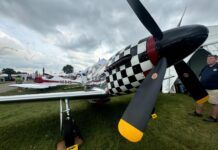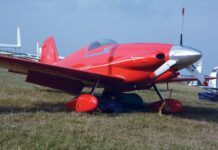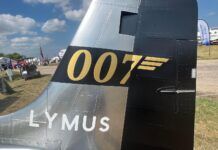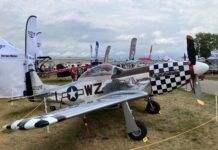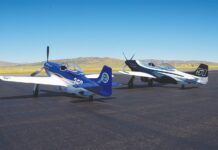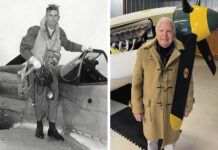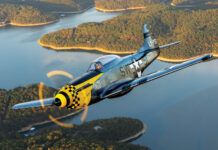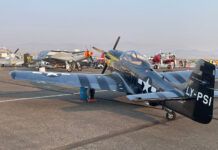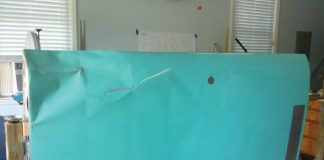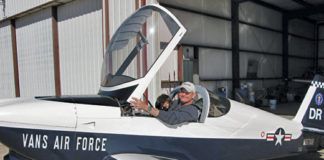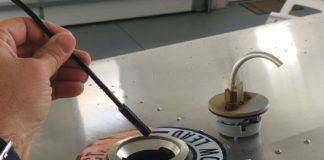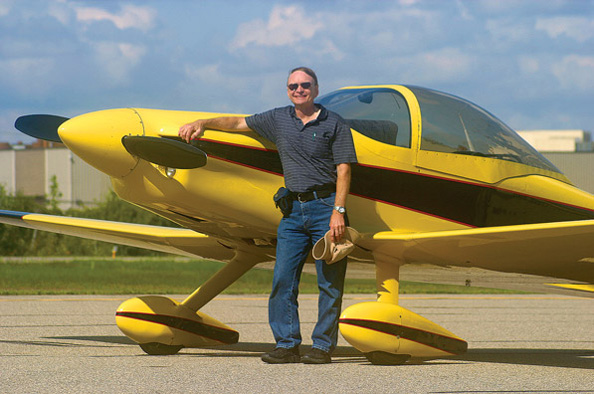
It isn’t every day that I get to fly a single airplane that’s both an historic icon and as desirable as the newest of the current crop of super-homebuilts. Long known as two of homebuilt aviation’s evergreen designs, Mustang Aeronautics’ Midget Mustang and Mustang II have roots that go back more than 60 years, to Dave Long’s first prototype of a Formula One (then Goodyear Class) racer.
Back in 1948, Long was chief design engineer at Piper Aircraft in Lock Haven, Pennsylvania, but in his spare time he worked out the details of a slick single-seat miniature fighter plane. Naturally, he hoped to capitalize on the popularity of the P-51 Mustangs running in the Unlimited Class, calling his design the Midget Mustang, after initially christening it “P-Shooter.”
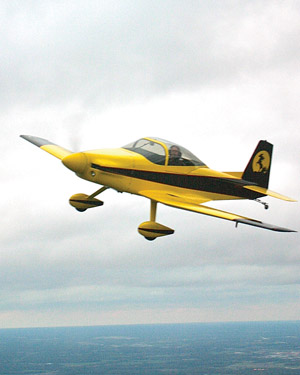
Kinder expertly flies formation in his Oshkosh Grand Champion Mustang II; during our test hop, it easily indicated 200 mph.
Long’s plan was to put the aircraft into production, as homebuilding was almost unknown in the late 40s, and Schweizer Aircraft in Elmira, New York, had agreed to build the planes. However, the requisite advance orders were slow to materialize in the general aviation doldrums of the early 1950s. Still, had it not been for Long’s untimely death in an engine-failure crash in mid-1950, the $5000 Midget Mustang could have wound up competing with the Mooney Mite.
By the late 50s, Experimental/Amateur-Built aviation was in its ascendancy, and entrepreneur Robert Bushby could see the potential of Long’s Midget; he purchased the rights and tooling in 1959. Bushby also responded to the clamor for a side-by-side two-seat version, and started working on the Mustang II while selling parts and plans for the Midget Mustang. He took the M-II prototype to the 1965 EAA Rockford fly-in, where it was warmly received, and that very airplane still exists, now under restoration by the current owners of the company.
60 Years Later…
Mustang Aeronautics acquired the design rights for both airplanes from Bushby in 1992. Young Chris Tieman, president of Mustang Aero, is an aeronautical engineering graduate of the University of Michigan; he and his father, Richard, have worked hard to upgrade the Mustangs and make them easier to build. Mustang Aeronautics is located just north of Detroit, near the Oakland-Troy Airport. We were pleased to get an invite to attend the company’s 2009 fly-in, tour the factory and see several prime examples of completed airplanes.
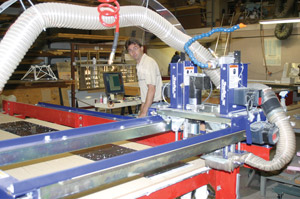
Much like their namesake, to which they bear only scant resemblance, the Mustangs are big on ramp appeal. They look fast, they are fast and they have a long history of durability and performance. The Midget Mustang and Mustang II are built the old-fashioned way, using 2024-T3 stressed-skin aluminum held together with lots of flush-head rivets dimpled into the skin. Fiberglass is employed for some of the complex shapes such as cowling pieces and fairings, but everything else is shiny Alclad. The airplanes can be entirely scratch-built from plans, or constructed from a series of subkits supplied by the factory. In the nearly 20 years since acquiring the design, Tieman has endeavored to make the building process simpler and more consistent.
In place of the eighth-inch rivets originally used, Tieman opted for an increased count of 3⁄32-inch rivets, which are easier for average first-time builders to drive. Pre-drilling pilot holes in the fuselage bulkheads made it simpler to drill holes to attach the fuselage skins without measuring. Wingskins now come with the leading edge pre-bent, and flanges are pre-formed on most other metal parts. And more of the individual parts are available for purchase from the factory, saving the scratch-builder from creating them out of flat stock.
Most importantly, Mustang Aeronautics has responded to the clamor for easy-to-assemble kits, allowing a builder to complete subkits of major segments such as the center section, gear, fuselage, empennage and wings, or buy a kit for the complete aircraft. Dedicated scratch-builders can still order a set of construction drawings and have at it, but most will use at least some of the available parts and subkits. It makes more sense to purchase the airplane in subkits as needed, Tieman says, though overseas builders, who make up about 30% of the customers, tend to order complete kits. Lead time for delivery of a full kit runs about 11 weeks.
How It’s Built
The Mustang II was created by attaching Midget Mustang wings to a zero-dihedral center section. Five degrees of dihedral are used in these tapered outer panels, along with 2.5° of washout. The Mustangs use a laminar-flow 64a212 wing section with a fairly sharp leading-edge radius and a 40% chord thickness. Because the wing’s airflow is somewhat critical, early scratch-built Mustangs can exhibit variations in performance from plane to plane, particularly at low speed. Tieman has addressed this issue in various ways; pre-bending the airfoil shape into the leading edge of the wingskins is done at the factory, and the critical center section now comes completed and powder-coated, ready for the wingspars to attach with the dihedral angle set. Plansbuilders are encouraged to buy factory-made wing jigs for their projects, and then sell them back to Mustang Aeronautics afterward at a slight discount.
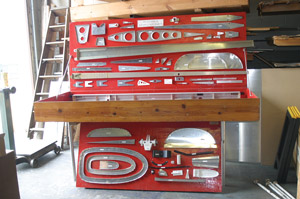
As shown on display for the factory open house, Mustang parts can be purchased in kit form or individually, saving tedious creation of form blocks, bending of flanges, measuring and drilling.
Alternatively, Mustang Aero offers a complete quickbuild wings option, by which the airfoil variations are eliminated, thus sparing the builder the need for jigs. Just introduced, a lower-cost partially completed (basically unskinned) wing option is being offered, which still eliminates the jigging requirement but also cuts the cost by almost 40%.
The Mustang II’s outer wings can incorporate a folding feature, using a swivel attachment near the trailing edge; about a quarter of the kits ordered specify this option. Tieman says folding the wings is most useful for sharing hangar space to cut storage costs, rather than for trailering, though the M-II slims down to legal road width with the wings folded. To stow the wings, the three bolts holding the wings to the main and aft spars are unscrewed, allowing the 55-pound panel to be rotated leading-edge up and walked aft to the tail cone, where a saddle bracket atop the tail cone receives the wingtip. Because the ailerons are pushrod actuated, the control linkage disconnect and hookup is automatic; the outer pushrods simply ride against flat bearing surfaces on a bell crank when the wing is in place. Fuel is typically contained in a nose header tank and in the outer wing panels, so the wing tanks should be empty if the wings are to be folded to reduce the weight.
The Mustang II’s flap is a single drag flap that covers the entire aft section of the center section, including the portion under the fuselage, DC-3 style. The Midget Mustang uses dual flaps on the wing panels, because it has a short center section. Ailerons are attached by full-length upper piano hinges, giving a gap-seal effect.
The maingear legs are attached partially outboard, creating a wide span for good ground handling; gear tread measures 6-foot-9 inches for the Mustang II, 5-foot-1 inch for the M-I. A recent change from steel gear legs to 7075 aluminum saves 20 pounds. A tricycle-gear option for the M-II is gaining in popularity, now making up about 40% of sales. A spring-steel strut attached to the engine mount is used for the nosegear, mounting a Lamb 4-inch tire. Maingear tires are 5.00×5.
Fuel system options are varied. As with the Midget Mustang, the original Mustang II design called for a header tank aft of the firewall, 15 gallons for the M-I and 11 or 25 gallons for the M-II. However, builders quickly adopted larger engines than the Lycoming O-290 of the prototype Mustang II, leading to a need for supplemental fuel in wing tanks, wet-wing bays and tip tanks. A popular wet-wing option uses the aft spar as the rear wall of the tank, so lightening holes aren’t cut in that area when the factory makes up the spar. This provides an extra 18 gallons on each side for the Mustang II, 10 gallons per wing for the Midget Mustang.
The Midget Mustang was designed around the small-bore Continentals (the most popular of which is the O-200). Builders quickly adopted larger powerplants, up through the O-320 Lycoming, which decidedly changed the character of the lightweight racer. Mustang Aero recommends the 150- to 160-horsepower option only for experienced pilots. Primarily a cross-country cruiser, the Mustang II uses four-cylinder Lycoming powerplants from the O-320 to the IO-390, with either a fixed-pitch or constant-speed propeller. The Mustang II battery normally resides in the aft fuselage, adjacent to the 80-pound baggage bin behind the seats.
The empennage of both the Midget Mustang and Mustang II uses a cable-actuated rudder, while the elevators are controlled by an aluminum pushrod. Midget Mustangs were first built with a high turtledeck and a one-piece swing-over canopy, but a two-piece sliding bubble canopy with a lowered turtledeck is now available, as the M-IA option. The Mustang II’s sliding canopy can be either a T-18 style flat-top unit or a rounded bubble canopy. The windshield has been changed from a blunt T-18 unit to a bubble-type windscreen with better optics.

How Does It Fly?
Only one Midget Mustang was present at the 2009 fly-in (the factory demonstrator), but a good assortment of Mustang IIs flew in, despite threatening, gusty weather. Larry Kinder arrived from Elko, Minnesota, in his 1991 Oshkosh Grand Champion Mustang II, a striking yellow and black speedster. He agreed to let me have a short introduction to the joys of Mustang flying, after the winds abated in late afternoon and before the night’s rain showers moved in.
Kinder’s airplane has accumulated more than 1300 hours since he first flew it in 1981, and it still looks brand new. Mustang owners tend to fly their airplanes, not just build them to look at; some have put 3000 hours on them. As with all homebuilts, each is unique and undergoing continual tweaking. Kinder’s fuel system eschews the header tank for an underseat tank of 11 gallons, supplemented by an 18.75-gallon wing tank on each side. This 48.5-gallon supply is plenty for the 180-hp IO-360 Lycoming, which was removed from a 1968 Piper Arrow. Its dual ignition incorporates a Light Speed electronic system on one position, with the conventional magneto retained on the other.
For boarding, the seat cushion is flipped up, Grumman style. I stepped in over the side and lowered myself into place using the canopy side rail and a beefy windshield frame tube, which doubles as turnover structure. Once settled in, there’s ample elbow room, though Kinder did incorporate a removable control stick on the right side to allow full aileron movement when an ample passenger leg would be interposed between an extended flap handle and the stick. The seats are ground adjustable to accommodate varying leg lengths.
Kinder’s panel is set up primarily for VFR traveling, though he is instrument rated. Empty weight is 1060 pounds, with gross weight set at 1600 pounds. The power quadrant uses just the knobs from a Piper product; the pedestal itself is his own work. An adjustable cowl flap under the nose is opened only in extremely hot conditions. Visibility for taxiing is good, because the Mustang’s upper cowling is relatively flat from the windshield forward; with proper seat cushions, little S turning is needed.
Controls were confirmed free and clear, and both trim wheels on the central tunnel were verified neutral; the aft wheel is for an adjustable aileron tab on the left wing. Checking for approaching traffic requires only some head-swiveling, thanks to the expanse of canopy, and with an advisory on Oakland-Troy’s 123.05 CTAF, we were off.
Oh, Yeah!
Acceleration with our low power loading was like a dragster hauling out of the chute. There’s plenty of rudder to control the torque, Kinder said. The airplane broke ground at about 70 mph, using approximately 800 feet of runway, and charged upward into an impatient climb. At 120 mph IAS, which was probably far in excess of any Vy, we indicated a steady 1600 fpm before we had to level off at 3000 feet to stay VFR.
Cruise power was pulled back to 23 inches and 2350 rpm, which eventually resulted in an indicated airspeed right up against the yellow arc, established at an even 200 mph. At speed, the controls are nicely balanced; the ailerons stiffen up at 200 mph, but still produce a 190° per second roll rate, according to Tieman’s specs, and I concur. Pitch control is not at all hair-trigger sensitive, unlike many small homebuilts, and the rudder is powerful without being touchy. Stick-free off-trim recovery was essentially deadbeat, settling back to trim speed with but one overshoot. Picking up a wing with rudder produced immediate results. I essayed some very satisfying lazy-eight maneuvers, with full credit given to the airplane, not my flying.
The Mustang II is reportedly stressed to 9 G ultimate, with a 6-G flight load factor observed for all normal operation. However, I wouldn’t consider it an aerobatic mount because of its quick acceleration on the down line. The Mustang’s fun to fly as a quick cross-country traveler, and with a simple autopilot it would make a suitable IFR platform.
The stall checks were, as predicted, non-events, exhibiting proper stick-loading as the speed bled off. There was only a hint of burble as the stall broke; Kinder’s right wing always drops first, he noted. Indicated stall speed, for what it’s worth, was about 63 mph flaps up, and only a couple of knots slower with the flaps down. Altitude loss was 200 feet or so before we were flying again.
All too soon, it was time to let down into the still gusty low-level winds. Kinder said the descent profile is one of his challenges with the airplane, which could use speed brakes. When letting down from high altitudes with a tailwind, he has to start the descent 100 miles out to avoid overflying his destination. We rolled into a 45° bank to pull off speed and got down to the pattern altitude in one circle. I expected to fly final at 100 mph or so, but Kinder rejected that idea. The pattern was flown at 90 mph and final approach required only 75 with the belly flap down (Vfe is set for 100 mph). He says he works short strips by coming over the fence at 70 mph, and, sure enough, we floated interminably before touching down at 60 or so. Rollout with minimal braking ended after using about 2000 feet of pavement.
The Mustang II proved to be a fine handling little airplane, performing for all the world as if I were sitting in a much larger aircraft. With the 360-cubic-inch Lycoming and a constant-speed prop, it’s a real tiger, and a 320-inch engine with the correct fixed-pitch prop would still deliver ample performance. With the quickbuild kits now offered by Mustang Aeronautics, the building process is no longer as daunting as it was when Kinder built his airplane, and the results are much more predictable. Just goes to prove that a veteran design can be improved over time without losing the very things that made it popular.
For more information, call 248/649-6818 or visit www.mustangaero.com.

